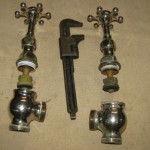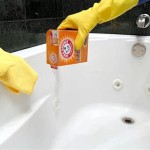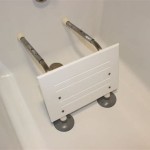How To Clean a Dirt-Stained Bathtub
A bathtub, intended as a sanctuary for relaxation and personal hygiene, can quickly become a repository for dirt, grime, and soap scum. Over time, these accumulated residues can lead to unsightly stains that detract from the bathroom's overall appearance and potentially harbor bacteria. Maintaining a clean bathtub requires a consistent cleaning regimen and the application of appropriate cleaning techniques to effectively remove dirt stains and restore the tub's original luster. This document outlines several methods for cleaning dirt-stained bathtubs, considering various materials and stain severity.
Essential Tools and Materials
Effective bathtub cleaning necessitates the use of appropriate tools and cleaning agents. The selection of these items is critical to prevent damage to the bathtub's surface and ensure efficient dirt removal. The following list details essential tools and materials commonly used for cleaning dirt-stained bathtubs.
Cleaning Agents: The choice of cleaning agent is paramount and depends on the bathtub material and the nature of the stain. Common options include:
- All-Purpose Cleaners: Suitable for light dirt and grime, these cleaners are readily available and often contain degreasing agents.
- Bathroom Cleaners: Specifically formulated for bathroom surfaces, these cleaners often target soap scum, mildew, and hard water stains.
- Vinegar: A natural and acidic cleaner, vinegar effectively dissolves hard water stains and soap scum. White vinegar is generally preferred.
- Baking Soda: A mild abrasive cleaner that can be used alone or combined with vinegar to create a powerful cleaning paste.
- Hydrogen Peroxide: An effective disinfectant and stain remover, particularly useful for organic stains.
- Commercial Tub and Tile Cleaners: These cleaners are specifically designed for bathtub surfaces and often contain stronger chemicals for stubborn stains. Follow manufacturer instructions carefully.
Cleaning Tools: The appropriate cleaning tool will ensure effective scrubbing without scratching the bathtub surface.
- Non-Abrasive Sponges: These sponges are gentle on bathtub surfaces and ideal for general cleaning.
- Microfiber Cloths: Highly absorbent and effective at removing dirt and grime without leaving streaks.
- Scrub Brushes: For tougher stains, a scrub brush with nylon bristles can be used. Ensure the bristles are not too stiff to avoid scratching.
- Old Toothbrush: Useful for cleaning grout lines and hard-to-reach areas.
- Spray Bottle: For applying cleaning solutions evenly.
- Rubber Gloves: To protect hands from harsh chemicals and bacteria.
Protective Gear: It is essential to protect oneself from the harsh chemicals found in many cleaning agents.
- Rubber Gloves: To prevent skin irritation and protect hands from chemicals.
- Eye Protection: Safety glasses or goggles to prevent splashes from entering the eyes.
- Mask: Ventilation is important. A mask will protect lungs from inhaling fumes from chemical cleaners.
Cleaning Methods for Various Stain Types
The cleaning method employed should correspond to the type and severity of the dirt stain. Different types of stains require different approaches to ensure effective removal without damaging the bathtub surface. The following sections detail various cleaning methods for common dirt stain types.
General Dirt and Grime: For everyday dirt and grime, a simple cleaning solution often suffices.
- Wet the bathtub surface with warm water.
- Apply an all-purpose cleaner or a diluted bathroom cleaner to the entire surface.
- Allow the cleaner to dwell for a few minutes to loosen the dirt.
- Scrub the surface with a non-abrasive sponge or microfiber cloth, paying attention to areas with visible dirt.
- Rinse thoroughly with warm water.
- Dry the bathtub with a clean towel to prevent water spots.
Soap Scum: Soap scum is a common residue formed by the reaction of soap with hard water minerals. It appears as a white or gray film on the bathtub surface.
- Vinegar Solution: Mix equal parts white vinegar and warm water in a spray bottle.
- Spray the solution liberally onto the soap scum.
- Allow the solution to dwell for 15-20 minutes to dissolve the soap scum.
- Scrub the surface with a non-abrasive sponge or microfiber cloth.
- Rinse thoroughly with warm water.
- For stubborn soap scum, repeat the process or use a commercial soap scum remover.
Hard Water Stains: Hard water stains are caused by mineral deposits left behind by hard water. They often appear as white or yellowish stains and can be difficult to remove.
- Vinegar Soak: Fill the bathtub with a few inches of hot water.
- Add several cups of white vinegar to the water. The amount of vinegar depends on the severity of the stains.
- Allow the mixture to soak for several hours or overnight.
- Drain the bathtub and scrub the surface with a non-abrasive sponge or microfiber cloth.
- Rinse thoroughly with warm water.
- For localized hard water stains, saturate a cloth with vinegar and apply it directly to the stain, allowing it to dwell before scrubbing.
Rust Stains: Rust stains can occur around metal fixtures or from dripping faucets. They are typically reddish-brown in color.
- Lemon Juice and Salt: Mix lemon juice with salt to form a paste.
- Apply the paste to the rust stain.
- Allow the paste to dwell for several hours or overnight.
- Scrub the surface with a non-abrasive sponge or old toothbrush.
- Rinse thoroughly with warm water.
- Commercial Rust Remover: For more stubborn rust stains, use a commercial rust remover specifically designed for bathroom surfaces. Follow the manufacturer's instructions carefully.
Mold and Mildew: Mold and mildew thrive in damp environments and can appear as black or green spots on the bathtub surface, particularly in grout lines.
- Bleach Solution: Mix one part bleach with ten parts water in a spray bottle.
- Spray the solution onto the affected areas.
- Allow the solution to dwell for 10-15 minutes.
- Scrub the surface with a scrub brush or old toothbrush, paying particular attention to grout lines.
- Rinse thoroughly with warm water.
- Ensure proper ventilation during and after the cleaning process.
- Hydrogen Peroxide: As an alternative to bleach, spray hydrogen peroxide onto the mold and mildew and allow it to dwell for 30 minutes before scrubbing and rinsing.
Stubborn Dirt Stains: For stains that persist after trying the above methods, a more abrasive cleaning approach may be necessary. However, caution should be exercised to avoid damaging the bathtub surface.
- Baking Soda Paste: Mix baking soda with a small amount of water to form a thick paste.
- Apply the paste to the stubborn stain.
- Allow the paste to dwell for 30 minutes to an hour.
- Scrub the surface with a non-abrasive sponge or scrub brush.
- Rinse thoroughly with warm water.
- Commercial Stain Remover: Consider using a commercial stain remover specifically designed for bathroom surfaces, following the manufacturer's instructions carefully.
Bathtub Material Considerations
The material of the bathtub significantly influences the cleaning methods and cleaning agents that can be safely used. Different materials have varying levels of resistance to chemicals and abrasives. Using inappropriate cleaning methods can lead to scratches, discoloration, or other forms of damage.
Acrylic Bathtubs: Acrylic bathtubs are prone to scratching and should be cleaned with non-abrasive cleaners and sponges. Avoid using abrasive cleaners, scrub brushes with stiff bristles, or scouring pads. Mild dish soap, all-purpose cleaners, and specifically formulated acrylic bathtub cleaners are suitable options.
Porcelain Bathtubs: Porcelain bathtubs are more durable than acrylic bathtubs and can withstand slightly more abrasive cleaning methods. However, harsh abrasives can still damage the finish. Baking soda paste, soft scrub brushes, and commercial tub and tile cleaners are generally safe to use.
Cast Iron Bathtubs: Cast iron bathtubs with an enamel coating require gentle cleaning methods similar to porcelain bathtubs. Avoid using harsh abrasives or scouring pads that can scratch the enamel. Mild dish soap, baking soda paste, and commercial tub and tile cleaners are suitable options.
Fiberglass Bathtubs: Fiberglass bathtubs are sensitive to scratches and can be damaged by harsh chemicals. Use non-abrasive cleaners and sponges, and avoid using abrasive cleaners, scrub brushes with stiff bristles, or scouring pads. Mild dish soap, all-purpose cleaners, and specifically formulated fiberglass bathtub cleaners are recommended.
Stone Bathtubs: Stone bathtubs, such as those made of marble or granite, require specialized cleaning methods to avoid damaging the stone. Use pH-neutral cleaners specifically designed for stone surfaces. Avoid using acidic cleaners like vinegar or lemon juice, as they can etch the stone. Follow the manufacturer's instructions for cleaning and maintenance.
It is always advisable to consult the manufacturer's instructions for the specific bathtub material before using any cleaning agent or method. Testing the cleaning solution in an inconspicuous area is also recommended to ensure it does not cause any damage or discoloration.
Consistent maintenance is key to preventing dirt stains from forming in the first place. Regularly rinsing the bathtub after each use and wiping it down with a clean towel can help prevent the buildup of soap scum and hard water stains. A weekly cleaning routine using a mild cleaning solution can also help keep the bathtub clean and prevent the formation of stubborn dirt stains. By adhering to these preventative measures and employing appropriate cleaning techniques, a bathtub can remain a clean and inviting space for relaxation and hygiene.

How To Clean A Dirty Bathtub At Home With Ashley

How To Clean Your Bathtub The Home Depot

How To Clean Textured Fiberglass Or Plastic Shower Floor Baking Soda White Vinegar

How To Clean Bathtub Stains Diy Family Handyman

How To Clean A Porcelain Bathtub With Mr Sponge Or Magic Eraser Remove Dirt

What Is The Best To Clean A Bathtub Sparkling And Beyond

How To Clean A Really Dirty Plastic Bathtub Hunker
/how-to-clean-bathtub-1900292-04-d36adf30dce848f0887a1f08ddc81d58.jpg?strip=all)
How To Clean A Bathtub The Right Way

Sparkling Clean How To Re Your Dirty Tub

How To Clean A Bathtub The Right Way







